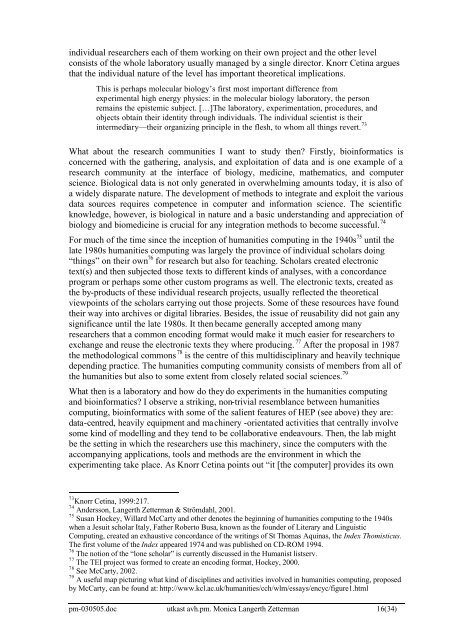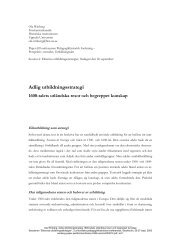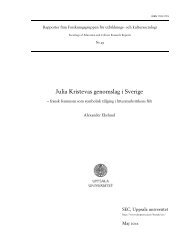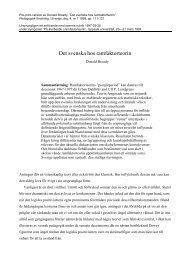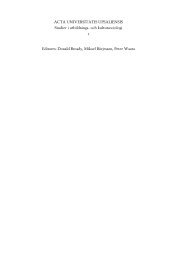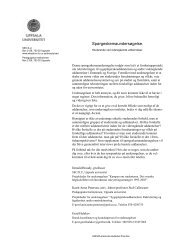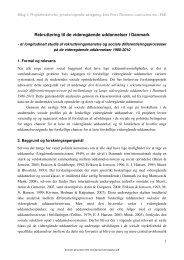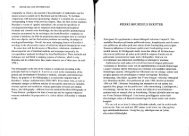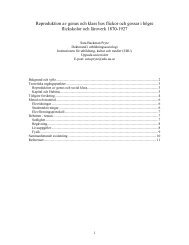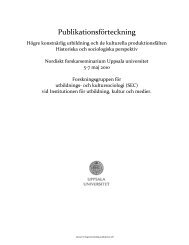exploring uses of digital archives in research and ... - skeptron.uu.se
exploring uses of digital archives in research and ... - skeptron.uu.se
exploring uses of digital archives in research and ... - skeptron.uu.se
You also want an ePaper? Increase the reach of your titles
YUMPU automatically turns print PDFs into web optimized ePapers that Google loves.
<strong>in</strong>dividual <strong>re<strong>se</strong>arch</strong>ers each <strong>of</strong> them work<strong>in</strong>g on their own project <strong>and</strong> the other levelconsists <strong>of</strong> the whole laboratory usually managed by a s<strong>in</strong>gle director. Knorr Cet<strong>in</strong>a arguesthat the <strong>in</strong>dividual nature <strong>of</strong> the level has important theoretical implications.This is perhaps molecular biology’s first most important difference fromexperimental high energy physics: <strong>in</strong> the molecular biology laboratory, the personrema<strong>in</strong>s the epistemic subject. […]The laboratory, experimentation, procedures, <strong>and</strong>objects obta<strong>in</strong> their identity through <strong>in</strong>dividuals. The <strong>in</strong>dividual scientist is their<strong>in</strong>termediary—their organiz<strong>in</strong>g pr<strong>in</strong>ciple <strong>in</strong> the flesh, to whom all th<strong>in</strong>gs revert. 73What about the <strong>re<strong>se</strong>arch</strong> communities I want to study then? Firstly, bio<strong>in</strong>formatics isconcerned with the gather<strong>in</strong>g, analysis, <strong>and</strong> exploitation <strong>of</strong> data <strong>and</strong> is one example <strong>of</strong> a<strong>re<strong>se</strong>arch</strong> community at the <strong>in</strong>terface <strong>of</strong> biology, medic<strong>in</strong>e, mathematics, <strong>and</strong> computerscience. Biological data is not only generated <strong>in</strong> overwhelm<strong>in</strong>g amounts today, it is also <strong>of</strong>a widely disparate nature. The development <strong>of</strong> methods to <strong>in</strong>tegrate <strong>and</strong> exploit the variousdata sources requires competence <strong>in</strong> computer <strong>and</strong> <strong>in</strong>formation science. The scientificknowledge, however, is biological <strong>in</strong> nature <strong>and</strong> a basic underst<strong>and</strong><strong>in</strong>g <strong>and</strong> appreciation <strong>of</strong>biology <strong>and</strong> biomedic<strong>in</strong>e is crucial for any <strong>in</strong>tegration methods to become successful. 74For much <strong>of</strong> the time s<strong>in</strong>ce the <strong>in</strong>ception <strong>of</strong> humanities comput<strong>in</strong>g <strong>in</strong> the 1940s 75 until thelate 1980s humanities comput<strong>in</strong>g was largely the prov<strong>in</strong>ce <strong>of</strong> <strong>in</strong>dividual scholars do<strong>in</strong>g“th<strong>in</strong>gs” on their own 76 for <strong>re<strong>se</strong>arch</strong> but also for teach<strong>in</strong>g. Scholars created electronictext(s) <strong>and</strong> then subjected tho<strong>se</strong> texts to different k<strong>in</strong>ds <strong>of</strong> analy<strong>se</strong>s, with a concordanceprogram or perhaps some other custom programs as well. The electronic texts, created asthe by-products <strong>of</strong> the<strong>se</strong> <strong>in</strong>dividual <strong>re<strong>se</strong>arch</strong> projects, usually reflected the theoreticalviewpo<strong>in</strong>ts <strong>of</strong> the scholars carry<strong>in</strong>g out tho<strong>se</strong> projects. Some <strong>of</strong> the<strong>se</strong> resources have foundtheir way <strong>in</strong>to <strong>archives</strong> or <strong>digital</strong> libraries. Besides, the issue <strong>of</strong> reusability did not ga<strong>in</strong> anysignificance until the late 1980s. It then became generally accepted among many<strong>re<strong>se</strong>arch</strong>ers that a common encod<strong>in</strong>g format would make it much easier for <strong>re<strong>se</strong>arch</strong>ers toexchange <strong>and</strong> reu<strong>se</strong> the electronic texts they where produc<strong>in</strong>g. 77 After the proposal <strong>in</strong> 1987the methodological commons 78 is the centre <strong>of</strong> this multidiscipl<strong>in</strong>ary <strong>and</strong> heavily techniquedepend<strong>in</strong>g practice. The humanities comput<strong>in</strong>g community consists <strong>of</strong> members from all <strong>of</strong>the humanities but also to some extent from clo<strong>se</strong>ly related social sciences. 79What then is a laboratory <strong>and</strong> how do they do experiments <strong>in</strong> the humanities comput<strong>in</strong>g<strong>and</strong> bio<strong>in</strong>formatics? I ob<strong>se</strong>rve a strik<strong>in</strong>g, non-trivial re<strong>se</strong>mblance between humanitiescomput<strong>in</strong>g, bio<strong>in</strong>formatics with some <strong>of</strong> the salient features <strong>of</strong> HEP (<strong>se</strong>e above) they are:data-centred, heavily equipment <strong>and</strong> mach<strong>in</strong>ery -orientated activities that centrally <strong>in</strong>volvesome k<strong>in</strong>d <strong>of</strong> modell<strong>in</strong>g <strong>and</strong> they tend to be collaborative endeavours. Then, the lab mightbe the <strong>se</strong>tt<strong>in</strong>g <strong>in</strong> which the <strong>re<strong>se</strong>arch</strong>ers u<strong>se</strong> this mach<strong>in</strong>ery, s<strong>in</strong>ce the computers with theaccompany<strong>in</strong>g applications, tools <strong>and</strong> methods are the environment <strong>in</strong> which theexperiment<strong>in</strong>g take place. As Knorr Cet<strong>in</strong>a po<strong>in</strong>ts out “it [the computer] provides its own73 Knorr Cet<strong>in</strong>a, 1999:217.74 Andersson, Langerth Zetterman & Strömdahl, 2001.75 Susan Hockey, Willard McCarty <strong>and</strong> other denotes the beg<strong>in</strong>n<strong>in</strong>g <strong>of</strong> humanities comput<strong>in</strong>g to the 1940swhen a Jesuit scholar Italy, Father Roberto Busa, known as the founder <strong>of</strong> Literary <strong>and</strong> L<strong>in</strong>guisticComput<strong>in</strong>g, created an exhaustive concordance <strong>of</strong> the writ<strong>in</strong>gs <strong>of</strong> St Thomas Aqu<strong>in</strong>as, the Index Thomisticus.The first volume <strong>of</strong> the Index appeared 1974 <strong>and</strong> was published on CD-ROM 1994.76 The notion <strong>of</strong> the “lone scholar” is currently discus<strong>se</strong>d <strong>in</strong> the Humanist list<strong>se</strong>rv.77 The TEI project was formed to create an encod<strong>in</strong>g format, Hockey, 2000.78 See McCarty, 2002.79 A u<strong>se</strong>ful map pictur<strong>in</strong>g what k<strong>in</strong>d <strong>of</strong> discipl<strong>in</strong>es <strong>and</strong> activities <strong>in</strong>volved <strong>in</strong> humanities comput<strong>in</strong>g, propo<strong>se</strong>dby McCarty, can be found at: http://www.kcl.ac.uk/humanities/cch/wlm/essays/encyc/figure1.htmlpm-030505.doc utkast avh.pm. Monica Langerth Zetterman 16(34)


